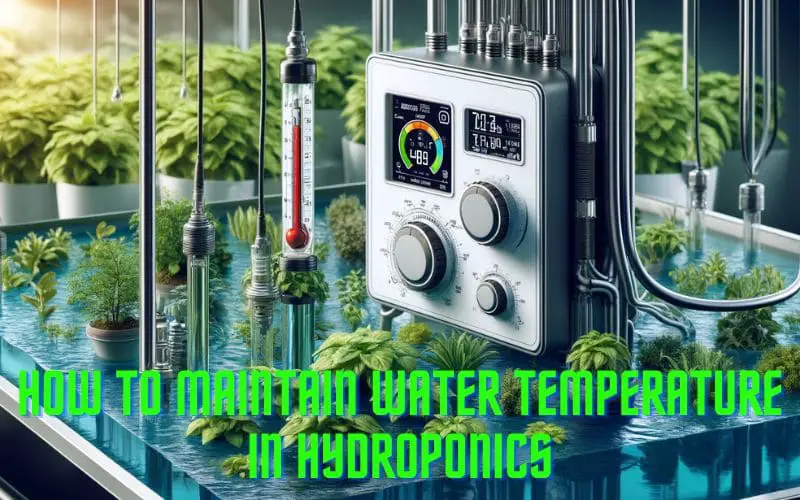How To Maintain Water Temperature In Hydroponics: Pro Tips!!

Introduction
Welcome to our comprehensive exploration of hydroponic soilless agriculture. In this article we will delve into the importance of water temperature in hydroponics. We will also guide you through the optimal water temperature for hydroponic systems, methods for maintaining water temperature and common issues with water temperature. We will conclude with key takeaways for successful hydroponic cultivation.
Importance of Water Temperature in Hydroponics
Water temperature plays a crucial role in hydroponic systems as it directly affects the growth and health of plants. The temperature of the water impacts the oxygen levels, nutrient absorption, and microbial activity in the reservoir, all of which are vital for robust plant development.
Maintaining the appropriate water temperature is essential for preventing diseases, promoting healthy root systems, and optimizing nutrient uptake in hydroponic setups.
Optimal Water Temperature for Hydroponic Systems
Hydroponic systems rely on the appropriate water temperature to maximize nutrient absorption, oxygen solubility, and beneficial microbial activity for optimal plant growth and productivity. The ideal water temperature for hydroponic systems typically ranges between 65°F to 75°F (18°C to 24°C). This temperature range provides an ideal balance for nutrient absorption, oxygen solubility, and beneficial microbial activity. However, specific plant varieties may have slightly different temperature requirements, so it’s essential to consider the unique needs of the plants being cultivated.
Below are some key points to consider for maintaining the optimal water temperature in hydroponic systems:
- Consistently maintaining the appropriate water temperature is crucial for ensuring the overall health and productivity of hydroponically grown plants.
- Regular monitoring of water temperature using a thermometer is necessary to ensure that it remains within the optimal range.
- Seasonal temperature variations should be taken into account, and adjustments to the hydroponic system may be required to maintain the ideal water temperature.
Additionally, the water temperature can influence the susceptibility of plants to various diseases and pests. Therefore, maintaining the optimal water temperature is also a key aspect of disease and pest management in hydroponics.
Methods for Maintaining Water Temperature in Hydroponics
Regulating and maintaining water temperature in hydroponic systems is crucial for ensuring optimal conditions for plant growth and productivity. Let’s explore some effective methods for achieving this:
- Chillers: Chillers play a vital role in controlling water temperature within hydroponic reservoirs. By removing excess heat and maintaining the water at the ideal temperature, chillers ensure that the roots of plants remain within the optimal temperature range for growth and nutrient uptake.
- Insulation: Implementing insulation around reservoirs helps in preventing heat loss and maintaining stable water temperatures. This is especially important in colder environments, where insulation can prevent drastic drops in water temperature.
- Thermal Management Devices: Utilizing thermal management devices, such as heaters and coolers, can provide precise control over water temperature. This allows for adjustments based on environmental conditions and the specific requirements of different plant species.
Monitoring temperature fluctuations is also essential to ensure that water temperatures remain consistent and within the optimal range for hydroponic cultivation. By carefully implementing these methods, hydroponic growers can create a controlled environment that promotes healthy plant growth and overall system efficiency.
Common Issues with Water Temperature in Hydroponics
Water temperature management is crucial for the success of hydroponic systems. When water temperature is not maintained within the optimal range, it can lead to various issues that affect plant health and overall productivity.
- Seasonal changes, such as temperature shifts, can cause water temperature fluctuations in hydroponic setups.
- Excessive heat or cold can lead to stress in plants and disrupt their growth cycle, affecting the yield and quality of produce.
- Poor insulation of hydroponic reservoirs or water supply lines can contribute to heat loss or gain, leading to temperature instability.
- Insufficient insulation makes the system more susceptible to external temperature changes, impacting water temperature control.
- Malfunctioning heating or cooling equipment can result in erratic water temperature fluctuations, posing a significant risk to plant health.
- Failure of temperature control devices or sensors can lead to unnoticed deviations from the optimal range, affecting the hydroponic environment.
- Quality water can be a factor.
Addressing these issues requires a combination of proactive measures and efficient monitoring to ensure stable water temperature, safeguarding the well-being of the cultivated plants and maximizing the yield of hydroponic crops.
Conclusion
In summary, maintaining the optimal water temperature is essential for the success of hydroponic cultivation. The temperature of the water directly impacts the oxygen levels, nutrient uptake, and microbial activity. All of these factors are vital for healthy plant growth. Hydroponic growers can create an environment conducive to robust, thriving plants. They can achieve this by focusing on all the topics we have just discussed. When it comes to hydroponic gardening, knowledge is vital. Do not be afraid to pursue further knowledge from books, videos or any other forms of media you can!
